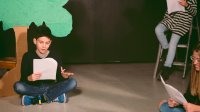Encouraging Social and Emotional Learning Through the Arts
Elementary students can build a sense of community and awaken a lifelong interest in the arts with these simple classroom strategies.
Your content has been saved!
Go to My Saved Content.Over the years, it’s become more evident that students need continued positive interactions with teachers and peers, meaningful assignments and activities that allow them to find and express their uniqueness, and creative outlets to deepen their knowledge.
This is where the arts come in. The arts offer many creative and fun ways to help elementary students build their social and emotional skills right in the classroom.
The Arts Build Community
If your students don’t feel like a community, they won’t work well together, and kids will feel out of place. They won’t want to take risks because they don’t feel safe. A good learning environment needs to have a sense of community.
Artistic experiences can bring people together, and it’s always a great idea to cultivate community in your classroom.
Art share: Giving space and time for students to share and think about art can be a great community-building activity. Students can discuss and reflect on their artwork or the work of others, music choices, or a favorite movie, as a whole class or as a small group or partner share.
Be sure to build in time for a discussion so that students can make connections with commonalities and differences. This is a great opportunity to guide students in how to talk with one another and carry on a respectful conversation.
Playing instruments: Having students create sounds and make music together can bring them closer. For this community-building activity, have a percussion circle. All you need to do is grab a few simple percussion instruments or objects that students can use to make percussive sounds (they can even use body percussion sounds: clapping, tapping, etc.), start a steady beat, and layer the sounds in. Everyone in the circle has a voice.
A percussion circle builds so many social competencies. Communication skills grow as students listen to others and then find their place within the sounds. Some musical leaders may even emerge. Cooperation is necessary to keep the music going, and smiles and laughter will bond your class together.
The Arts Help With Self-Awareness
Not only can art bring people together, but the arts can help students find mindful, quiet time to reflect on themselves. Self-awareness is a hard concept for many students, and developing that in a safe learning environment can be an essential part of our job as teachers. Many emotions will surface throughout the school year, and it’s important for us to help our students process these emotions.
Repeated patterns and doodles: Don’t underestimate the power of a doodle. Drawing simple, repetitive patterns can quiet the mind and help with self-management. There are times when I actually encourage my students to quietly create a border of doodles around a paper before they get started or when they finish. These doodles can even be content related, such as drawing repeated math symbols around a math worksheet.
This is also something you can model for your students in that odd two to three minutes you might have at the end of class, and then see where they take it. Give them an opportunity to draw repeated lines or waves on the corner of their planner or notebook and see what designs emerge.
Poems and monologues: Having students write a poem or a monologue for and about themselves is a great way for them to become more self-aware. These are two powerful tools to explore their interests, strengths, and emotions while sharing a bit of themselves with their classmates.
A prompt may look something like these:
- Create a haiku (or other poem) that describes your favorite hobby or activity.
- Write a monologue that explains why _____ (family, having friends, your pet, pizza, etc.) is so important to you.
The Arts Provide for Deep Learning of Content, Including SEL
Of course, our priority as educators is to help students understand concepts in our curriculum. And if students are having difficulty with this, then it’s our responsibility to find new tools and approaches to help them understand.
When you integrate the arts into the content you teach (no matter the subject or grade), your students will remember and understand the content at a much deeper level. The great thing is that you can also embed social and emotional skills into this work.
Dramatization: When students dramatize a scene in a story, not only are they analyzing the plot at a deeper level, but they’re able to put themselves in the characters’ shoes and more easily understand the emotions, thoughts, and motives of the characters in the scene.
Drawing students’ attention to this as they prepare and act out the scene is a great way to have them understand and cultivate empathy.
Music and history: Music has always played a huge role in portraying the times when it was composed. The next time you teach a certain historical event or period in time, consider adding in elements of the music that was popular during that era.
Giving students the opportunity to research the music and the artists who created it can give students a whole new insight into the human side of what was going on. Take, for example, the Civil War or the 1960s. That music was pivotal in telling the story of how people were feeling and can lead to some amazing discussions that inspire deep learning.
Finding authentic and creative ways to integrate the arts and SEL into your classroom can be a game changer for many teachers. With a couple of tweaks and simple activity ideas, you can have your students building their social and emotional learning right in your classroom.
